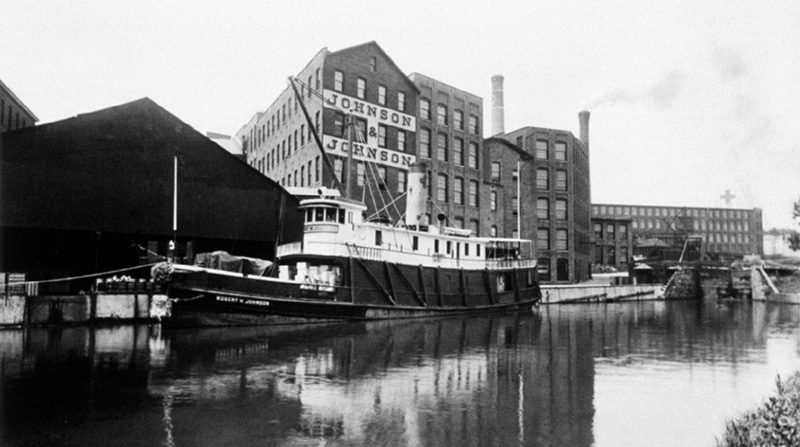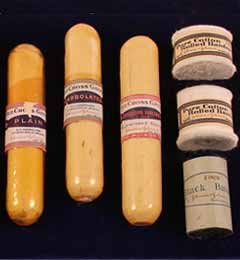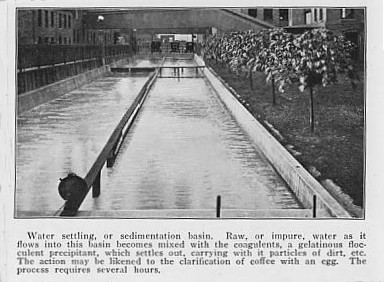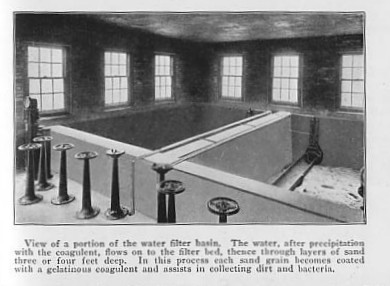Water!
Hmmm…it seems Kilmer House is back to the water theme this week. So, here goes: How did a serious water shortage in the Nineteen-teens end up benefiting the residents of New Brunswick? And what did Johnson & Johnson have to do with that?

In the Nineteen-teens, the City of New Brunswick faced a problem. The city got its water supply from a local brook, and the brook was going dry. The only other water source nearby – the river -- was too muddy to use without treating the water first….and anyway, it would take too much time to build a filtration plant to do any good in the face of an immediate shortage. But there already was a city resident with its own water treatment plant, and New Brunswick turned to that resident for help. Who was that resident? It was Johnson & Johnson.
A 1919 edition of THE RED CROSS MESSENGER carried an article by a druggist who toured the Johnson & Johnson facilities in New Brunswick, and heard the story of the water shortage. Here’s his description of what the Company did:
“A few years ago New Brunswick was threatened with a serious water famine. It takes its supply of water from a brook and this brook was going dry. Johnson & Johnson, who get their water from the Raritan River, saved the day for New Brunswick by hitching their plant to the city water mains and pumping filtered water into the homes of the city.” [THE RED CROSS MESSENGER, Vo. XI, No. 4, 1919, p. 97]
So Johnson & Johnson connected the city’s water system to the Company filtration and purification system to make sure the citizens of New Brunswick didn’t run out of water. Why? And why did the Company have a water purification system, anyway?
The Johnson family, the Kilmer family and many employees lived in New Brunswick, so the water shortage affected the people at Johnson & Johnson as well. Johnson & Johnson had a strong tradition of helping others when there was a need, as evidenced by the beginnings of its disaster relief program, its benefits for employees and the volunteer philanthropic work done by employees. So it was natural that, when there was a need in New Brunswick and Johnson & Johnson had the means to help, the Company would do so.

Early Cotton Products
As I mentioned in an earlier post, the Raritan River was muddy (and it still is!). The Company needed a lot of water to wash the cotton that was used in the manufacture of sterile surgical dressings and other products. Employees used water for the frequent hand washing with antibacterial soap that was required of them in making aseptic products, and the Company also supplied ice-cooled water for employees to drink. So Johnson & Johnson had built an elaborate filtration and purification system to make the Raritan water usable. (By the way, the ice to cool the drinking water was made from filtered water, too.) The system used sand, a purifying compound, and compressed air. And the Company’s standards were so strict that the purified water had to undergo and pass rigorous bacteriological testing by the Scientific Department before it could be used.

Part of the Company's Water Filtration System
But was there enough to supply an entire town? In order to meet manufacturing needs, the Company’s water purification system had the capacity to purify around 900,000 to one million gallons of water per day, according to Fred Kilmer. [THE RED CROSS MESSENGER, Vol. XI, No. 4, 1919 and THE RED CROSS MESSENGER Vol. V, No. 10, March 1913, p. 287]

Another Section of the Filtration System, Showing the Layers of Sand
So the Company stepped in and made sure its fellow citizens had water. But there was one problem. The cleaner, better tasting filtered water from Johnson & Johnson was such a hit with New Brunswick residents that they didn’t want their old water back when the shortage was over. The result, according to that long-ago observer?
“…the people liked it so well that they have since put in a municipal filtration plant.” [THE RED CROSS MESSENGER, Vo. XI, No. 4, 1919, p. 97]
So the next time you take a drink of water in New Brunswick, feel free to raise your glass to Johnson & Johnson.

This article is simply wonderful! I had no idea of the contributions Johnson & Johnson have made over 100 years! It's just wonderful to do a power point presentation on you! I love every old photo's and the stories they represent.
Sincerly yours
Ms. Marie Odoms
112 Palisades Point
Riverdale, Georgia 30274